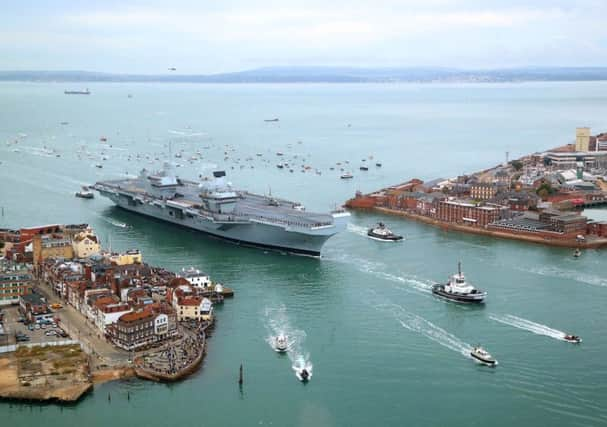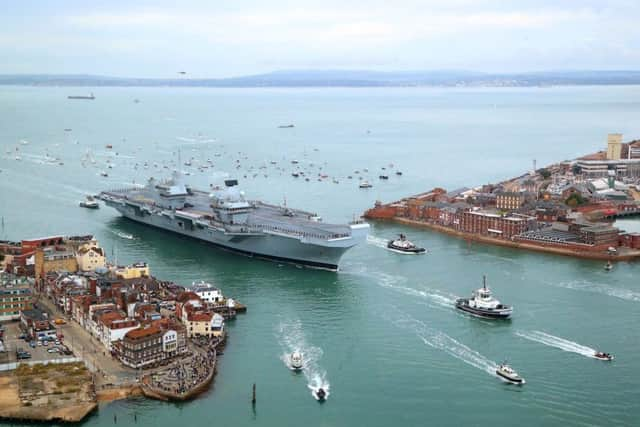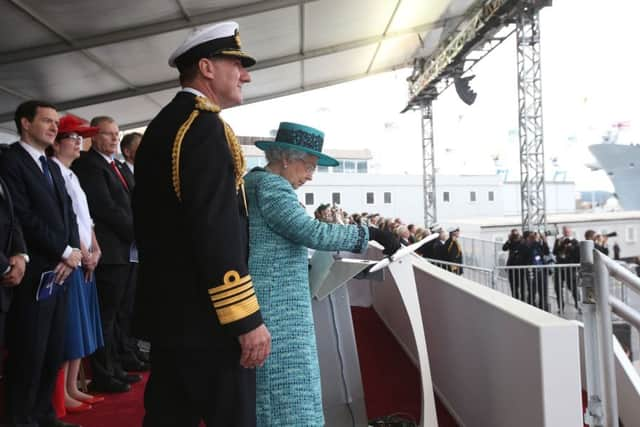Navy blue over news leak that rocked the boat


What’s more, the news of the leak had itself been leaked.
HMS Queen Elizabeth had been accepted into the fleet just 12 days earlier, with a lifespan of half a century, but now she was taking on 200 litres of sea water every hour.
The Navy had known about the defect when the Queen came aboard to conduct the commissioning ceremony, having identified it during seaworthiness trials – but had chosen to remain tight-lipped.


Advertisement
Hide AdAdvertisement
Hide AdThe security, however, was even less watertight than the propellor shaft at the root of the problem, and last night the top brass was left to mop up after a deluge of embarrassing publicity.
The fault, said officials, was “scheduled for repair” and would not prevent the ship from sailing again early in the new year.
Queen Elizabeth cost £3.1bn and the repairs will add a six-figure sum to the total. But, the Defence Secretary Gavin Williamson insisted, the extra cost would come from the contractors who had built her, not from the taxpayer.
The Aircraft Carrier Alliance, the group of companies which carried out the construction, blamed a leaky seal, which they put down to the type of “snagging” issues common with any new build. The consortium has a six-month period in which such adjustments can be rectified.


Advertisement
Hide AdAdvertisement
Hide AdIts spokesman said the vessel could be taken to sea, that the problem was expected to take “a couple of days” to fix, and that it should be rectified without any need to take the ship into a dry dock.
Shipbuilding yards around the country were involved in constructing the warship, including Govan and Scotstoun in Glasgow, Appledore in Devon, Cammell Laird in Liverpool, and A&P on the Tyne in Newcastle and at Portsmouth. It was then transported to Rosyth in Fife, where it was assembled.
As it arrived at its home base in Portsmouth for the first time in the summer, Theresa May hailed it as a “stunning piece” of 21st century engineering.
During her working life the ship can be pressed into action for high intensity war fighting and for providing humanitarian aid and disaster relief.


Advertisement
Hide AdAdvertisement
Hide AdShe will also serve as a floating military base for the F-35B stealth fighter jets that will launch from the deck of the vessel to undertake missions.
Mr Williamson was sanguine about the teething troubles. “This is the reason we have the sea trials, to make sure that everything is working absolutely perfectly,” he said.
“HMS Queen Elizabeth will be going out early on in the new year to continue her sea trials and making sure she is fully operable in terms of helicopters and the F-35 being able to fly off her deck.”
A Royal Navy spokesman added: “An issue with a shaft seal has been identified during HMS Queen Elizabeth’s sea trials; this is scheduled for repair while she is alongside at Portsmouth.


Advertisement
Hide AdAdvertisement
Hide Ad“It does not prevent her from sailing again and her sea trials programme will not be affected.”
The UK currently has 14 F-35s in the United States being tested ahead of flight trials off the ship next year, with one more plane being this month.
At 900ft long, HMS Queen Elizabeth is the size of three football pitches.
The scale of the propellor shaft leak can be gauged by the fact the two propellers on board weigh 33 tonnes each and produce enough power to run 1,000 family cars or 50 high speed trains
Advertisement
Hide AdAdvertisement
Hide AdA crew of around 700, rising to 1,600 when she becomes fully operational, is required on board. At their disposal are five gyms, a cinema and games room, with on-board facilities including a chapel, a medical centre and 12-bed ward, with three GPs and a dentist.
The ship, which has a top speed in excess of 25 knots, is expected to undergo at least two more years of tests before she is declared ready for action.